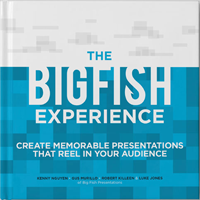Presentation Review: Elizabeth Gilbert on “Nurturing Creativity”
This week we decided to try something new. Instead of breaking down a presentation in segments, we thought we’d review a popular TED talk and discuss it in a different form. This week’s presentation features the author of the mega-bestseller “Eat, Pray, Love,” Elizabeth Gilbert. Gilbert, a former magazine writer turned novelist, delves into the concepts behind the roots and realities of the creative process. Throughout this talk, Gilbert reflects on her own success as well as that of others in order to convey her message.
Gilbert’s presentation is a very rapid and fluid one with a unique structure. Instead of hitting large, general points and pulling them together, she weaves them seamlessly and conversationally, like a close friend explaining her beliefs and theories to you in a coffee shop. She keeps it very intimate and personal. For instance, she is very honest when she speaks of her recent “freakish success” resulting from “Eat, Pray, Love.” She shows her humility in such an open and frank manner that the audience can’t help but enjoy her personality.
As she opens the presentation, Gilbert not only explains who she is and her past, but she also skims the surface of her central message, albeit in a very subtle way. She simultaneously identifies with her audience and addresses the topic. When she talks about people’s reactions to her success, she says, “Aren’t you afraid you’re going to keep writing your whole life and you’re never again going to create a book that anybody in the world cares about at all…ever…again?” Gilbert is connecting her story with her audience through a humorous, slightly uncomfortable situation, which everyone has had and with which they can identify.
Gilbert references many interesting historical examples to convey her message. She provides an extensive amount of credibility in her reasoning, which, when combined with her experiences, allows her to establish herself as an expert in the field of creativity. Gaining the audience’s trust is the first step, followed by gaining credibility. As Gilbert continues to delve into the more psychological constructs behind creativity and society’s perception of “genius,” we see a slight change in structure. Gilbert slows it down and examines the historical progression of creative perception in Greek and Roman societies. She promises that her brief background explanation will come full circle to her central message.
As she explains the history of the term “genius,” she leads into The Renaissance, which was a turning point in the concept’s history. She provides commentary about the belief system changing to a more empowered, humanistic form of creativity and inspiration, saying she thinks it was “a huge error.” Gilbert has come full circle and connected the historical context with the overarching message. This is a clever tactic, and is rarely used so seamlessly. We can barely tell that we have just received a history lesson because Gilbert’s tone and direction are so smooth and rehearsed.
After Gilbert’s explanation and commentary about the past, we enter a new stage of the presentation. Gilbert gives us the big idea. She proposes that the reason for the deaths of artists/writers over the past 500 years is due to the burden mankind has placed on supposed “geniuses.” We gave them labels and now we are asking how to change it. Gilbert seeks to go back to the old way of thinking. She asks, “Why not?” This is a crucial moment in the presentation because it signifies that we have received enough information about the topic to answer this question. We are on the verge of receiving an answer, which Gilbert provides soon enough.
The answer comes in the form of two stories about different artists dealing with the “genius” concept. Gilbert explains her rationale through commentary about these anecdotes. She gives the audience the full-size answer and creates a subtle call-to-action in the process. By explaining the concept in such detail and providing examples and commentary, Gilbert has given the audience enough information to think for themselves. Once they have that knowledge and insight, she provides accounts of notable people who believe in this idea in order to provoke action from the audience.
Gilbert provides a solid, seamless argument for the nurturing of creativity by looking outside our perceived notions of “genius.” Her approach to the presentation involves three major tactics. Firstly, she uses humility to connect with her audience. Secondly, she provides historical context, which establishes credibility. Lastly, she uses a subtle call-to-action approach and anecdotes to get the audience thinking for themselves.
We give this talk a huge thumbs up. This is a great case study about the importance of careful, subtle, and even pleasant delivery of the message by incorporating anecdotes, history and a purpose-driven core into the fiber of the presentation.
Well, we hope you’ve enjoyed our discussion! Please give us some feedback! What do you think about this review? Any thoughts about creativity? Tweet us or comment below or on Facebook, and as always, subscribe to our YouTube page!





Share your opinion.